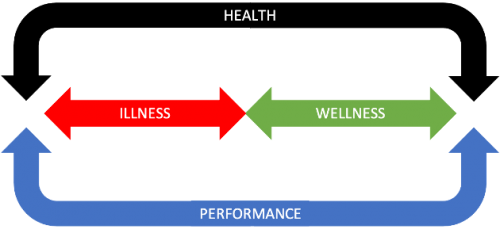
The Continuum of Mental Health & Performance
0
173

Welcome back! Before discussing the relationship between mental health and athletics specifically, we want to first discuss a common point of misunderstanding about mental health and wellness: the similarities and differences between symptomatology and diagnoses and why understanding and acknowledging both is vital to understanding mental health and improving performance.
Most of us are probably familiar with the term “diagnosis.” The American Psychological Association defines diagnosis as “the process of identifying and determining the nature of disease or disorder by its signs and symptoms, through the use of assessment techniques and other available evidence,” and “the classification of individuals on the basis of disease, disorder, abnormality, or set of characteristics” (APA, 2021). Diagnoses are determined by mental health professionals with use of the DSM-5, which includes thresholds for various disorders and mental illnesses. Diagnoses are extremely important as they can help individuals understand why they are behaving or feeling a certain way and offer specific treatment plans to minimize symptoms. However, there are negative aspects to considering the world of mental health only in terms of diagnoses.
One of the drawbacks to diagnoses is that they exist categorically. An individual either meets the criteria for a diagnosis or they do not, even if they are showing symptoms that are a departure from mental wellness. This can be harmful to someone experiencing these negative feelings and emotions if they feel like those feelings are invalid simply because they do not meet diagnostic criteria. This is where the concept of symptomatology comes in. The American Psychological Association defines symptomatology as “the combined signs, markers, or indications of a disease or disorder” (APA, 2021). Someone can experience symptomatology without experiencing a diagnosable mental health disorder and acknowledging and understanding this can be extremely beneficial to understanding mental wellness.
So why is understanding the difference between diagnoses and symptomatology important? As seen in the graphic below, they exist on a continuum with health and performance. In the graphic, the colored arrows in the middle represent mental wellness, the “wellness” arrow being a non-diagnosis while the “illness” arrow is a diagnosis. However, these are continuums, not categories. The severity of symptomatology is part of what determines where on the arrows an individual falls. The black arrows correspond to mental health as well as physical health in a few cases and the blue arrows correspond to performance across all aspects of life: athletic, social, career, etc. These are all important to understand because of the ways in which the three arrows move together. If mental health was categorical, then the “wellness” arrow would always correspond with peak mental health and performance. This is not the case. Understanding the deeper nuances of symptomatology and wellness, the importance of growing and tending to one’s mental health, even outside of a diagnosis becomes more apparent. Additionally, one way to increase performance is to work through negative thoughts, feelings, and any other symptoms one might be experiencing.
Note. Mental health and performance continuum of care model. Association for Applied Sport Psychology, 2021
We want to make it very clear that we are not trying to say diagnoses are unimportant. They offer vital information about what one is experiencing and can be invaluable when planning and monitoring treatments. However, education and understanding about mental health is more complete when considering where one falls on a continuum. This understanding is invaluable to fostering and increasing mental wellbeing. At TOPPS, there are mental health professionals who can offer support for anyone experiencing symptoms of mental illness. If any of the information above or in the next few posts resonates with you, please don’t hesitate to reach out to our staff. For more information on the staff and services provided, click here or contact us at admin@txopps.com.
References:
American Psychological Association. (n.d.). APA Dictionary of Psychology. American Psychological Association. Retrieved November 1, 2021, from https://dictionary.apa.org/diagnosis.
American Psychological Association. (n.d.). APA Dictionary of Psychology. American Psychological Association. Retrieved November 1, 2021, from https://dictionary.apa.org/symptomatology.
Association for Applied Sport Psychology (2021, August 17). AASP statement on the continuum of Mental Health & Relationship to performance: A response to the conversation supporting Naomi Osaka and Simone Biles. Association for Applied Sport Psychology. Retrieved November 18, 2021, from https://appliedsportpsych.org/media/news-releases-and-association-updates/aasp-statement-on-the-continuum-of-mental-health-and-relationship-to-performance-a-response-to-the-conversation-supporting/







